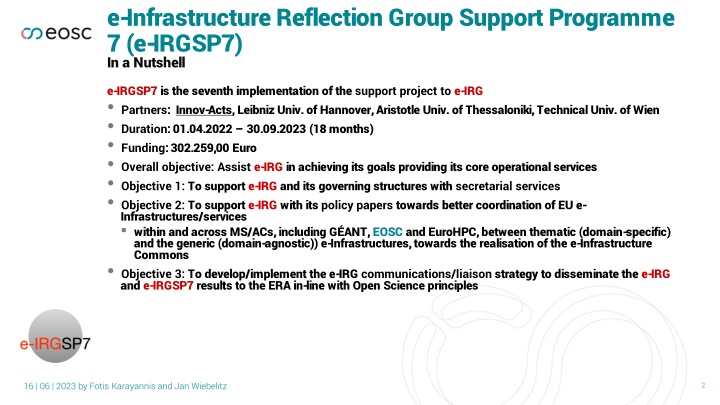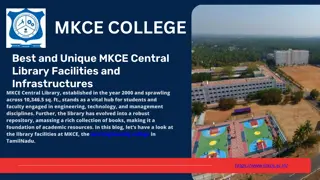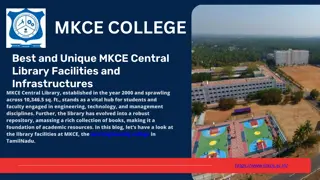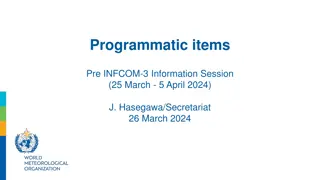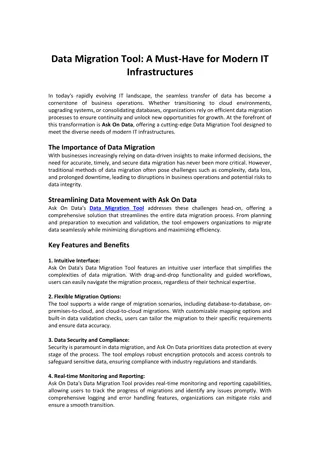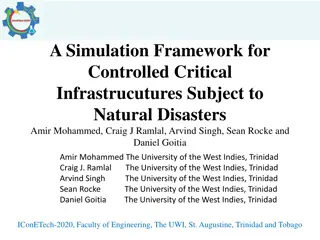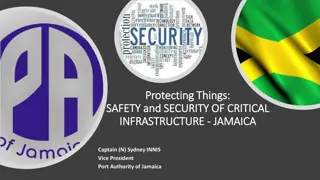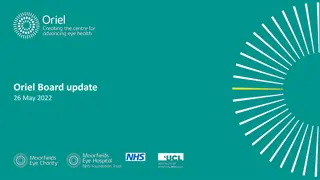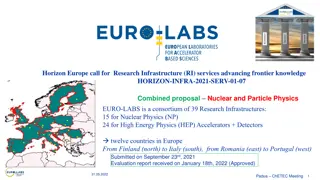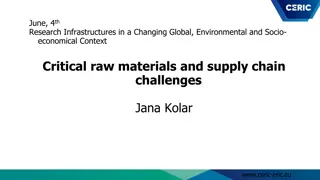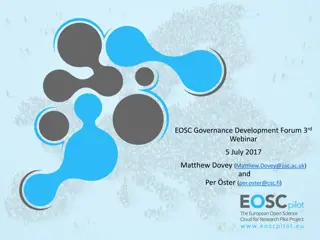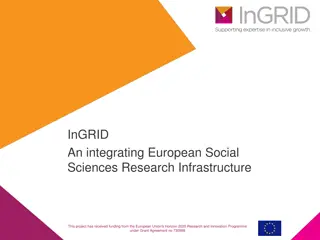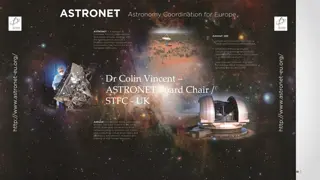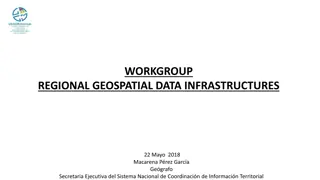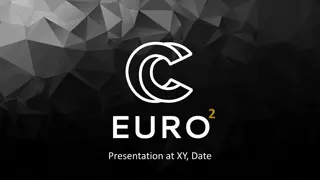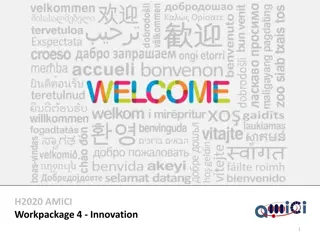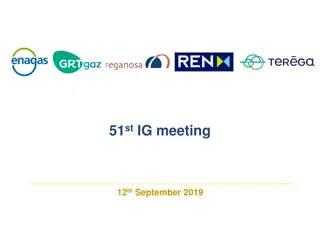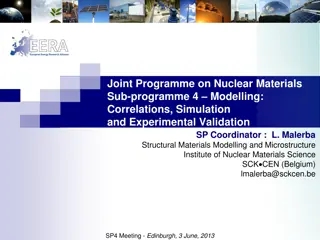Overview of e-IRGSP7 Programme Supporting European e-Infrastructures
e-IRGSP7 is the seventh implementation of the support project for e-Infrastructure Reflection Group (e-IRG), aimed at assisting in achieving their goals. This program supports e-IRG with secretarial services, policy papers for coordination of EU e-Infrastructures, and developing communication strategies to disseminate results to the European Research Area.
Download Presentation

Please find below an Image/Link to download the presentation.
The content on the website is provided AS IS for your information and personal use only. It may not be sold, licensed, or shared on other websites without obtaining consent from the author.If you encounter any issues during the download, it is possible that the publisher has removed the file from their server.
You are allowed to download the files provided on this website for personal or commercial use, subject to the condition that they are used lawfully. All files are the property of their respective owners.
The content on the website is provided AS IS for your information and personal use only. It may not be sold, licensed, or shared on other websites without obtaining consent from the author.
E N D
Presentation Transcript
e-Infrastructure Reflection Group Support Programme 7 (e-IRGSP7) In a Nutshell e-IRGSP7 is the seventh implementation of the support project to e-IRG Partners: Innov-Acts, Leibniz Univ. of Hannover, Aristotle Univ. of Thessaloniki, Technical Univ. of Wien Duration: 01.04.2022 30.09.2023 (18 months) Funding: 302.259,00 Euro Overall objective: Assist e-IRG in achieving its goals providing its core operational services Objective 1: To support e-IRG and its governing structures with secretarial services Objective 2: To support e-IRG with its policy papers towards better coordination of EU e- Infrastructures/services within and across MS/ACs, including G ANT, EOSC and EuroHPC, between thematic (domain-specific) and the generic (domain-agnostic)) e-Infrastructures, towards the realisation of the e-Infrastructure Commons Objective 3: To develop/implement the e-IRG communications/liaison strategy to disseminate the e-IRG and e-IRGSP7 results to the ERA in-line with Open Science principles 16 | 06 | 2023 by Fotis Karayannis and Jan Wiebelitz 2
e-Infrastructure Reflection Group Support Programme 7 (e-IRGSP7) In a Nutshell e-Infrastructure Reflection Group (e-IRG) Leading advisory body on e-Infrastructure policy in Europe,founded in 2003 -20 years anniversary (after first e-IRG workshop in June 2003!) Composed of 68 national delegates from Member States and Associated Countries (Science/Ministry), EC (DG CNECT,RTD),and observer from ESFRI Vision:to facilitate integration in the area of European e-Infrastructures and connected services,within and between member states,at the European level and globally Mission: to support both coherent, innovative and strategic European e-Infrastructure policy-making and the development of convergent and sustainable e-Infrastructure services Disclaimer:Opinions raised in this presentation are of e-IRGSP7,not necessarily of e-IRG 16 | 06 | 2023 by Fotis Karayannis and Jan Wiebelitz 3
Key Contributions to EOSC SRIA Contribution of e-IRGSP7 e-IRGSP7 is supporting e-IRG in its mission towards the implementation of the e-Infrastructure Commons. The e-Infrastructure Commons is the political, technological, and administrative framework for an easy and cost-effective shared use of distributed electronic resources across Europe. The e-Infrastructure Commons can be defined as an integrated living ecosystem of resources and services that is open, user friendly and accessible to European researchers and scientists, and continuously adapts to the changing requirements of research and science. Indirectly, harmonization of policies across countries via e-IRG delegates meetings and relevant discussions. In the policy area, providing recommendations with the different e-IRG papers. E.g. coordination inside countries, coordination across e-Infrastructures (G ANT, EOSC, EuroHPC, EU Data Spaces), coordination between thematic (domain specific) and horizontal (domain agnostic) e-Infrastructures/Research Infrastructures, etc. https://e-irg.eu/e-infrastructure-commons/ 16 | 06 | 2023 by Fotis Karayannis and Jan Wiebelitz 4
Key Contributions to EOSC SRIA Contribution of e-IRGSP7 Key recommendations from e-IRG White Paper 2022 (1/2) European and national e-Infrastructure providers Appropriate coordination among all stakeholders is required through a coordination platform, implementing a distributed multi-stakeholder model of cooperation and coordination. The coordination platform should allow a staged and gradual approach at the e-Infrastructure landscape, moving towards more integrated and joint services. e-IRG recommends to the e-Infrastructure providers to form a Forum or Assembly e-IRG is willing to have a facilitating role, if found appropriate, and not a steering one. It is also recommended that the e-Infrastructures agree on a lightweight structure, and also a lightweight means to monitor/report the progress of the cooperation activities. e-IRG recommends regular gatherings of the Forum to keep the discussion going and establish some form of open documentation to provide transparent progress monitoring. 16 | 06 | 2023 by Fotis Karayannis and Jan Wiebelitz 5
Key Contributions to EOSC SRIA Contribution of e-IRGSP7 Key recommendations from e-IRG White Paper 2022 (2/2) European Commission Appropriate support for the European strategy setting and coordination bodies and their umbrella forum or other lightweight structure is required; e-IRG recommends that in future Work Programmes the EC provides strong incentives for cross platform innovations, thereby further supporting the need for coordination and consolidation of e-Infrastructure service development and provisioning at the national and the European level. e-IRG recommends to recognise the importance of e-Infrastructures in the realisation of the European Open Science Cloud, and provide a clear definition of EOSC with its e-Infrastructure components and corresponding boundaries. Thematic infrastructures, communities, users e-IRG recommends to the thematic infrastructures and representatives of communities to actively follow the discussions of the e-Infrastructure Forum or Assembly, and to agree on some rotating representation in the Forum, inline with the Forum views. This will allow the provision of needs from the user side and balance the top-down with bottom-up approaches. 16 | 06 | 2023 by Fotis Karayannis and Jan Wiebelitz 6
Key impacts and deliverables e-IRGSP7 e-IRG recommends to recognise the importance of e-Infrastructures in the realisation of the European Open Science Cloud, and provide a clear definition of EOSC with its e-Infrastructure components and corresponding boundaries. e-IRG White Paper 2022 (https://zenodo.org/record/7584778 ) Coordination meetings between e-IRG and leading European e-Infrastructures took place and will be continued to establish a lightweight coordination structure. 16 | 06 | 2023 by Fotis Karayannis and Jan Wiebelitz 7
Dependencies and Collaborations e-IRGSP7 e-IRGSP7 supports the liaison activities of the e-Infrastructure Reflection Group at the policy level e-IRG EOSC Steering Board e-IRG e-Infrastructure-related initiatives (network, computing, data and related services): e-Infra Assembly e-IRG ESFRI-EOSC: Observer in ESFRI and also in the new ESFRI-EOSC Task Force e-IRG FAIRDo Forum (collaboration) e-IRGSP7 EOSC Association / EOSC Forum e-IRGSP7 is open for input from and collaborations with all ESOC-related projects, because the interconnection of policy and operation is of utmost importance for the realisation of the e-Infrastructure Commons and the implementation of the EOSC. 16 | 06 | 2023 by Fotis Karayannis and Jan Wiebelitz 8
Your vision e-IRGSP7 On the policy level EOSC e-Infrastructures A mix of federated and integrated services across countries, regions, EU e-Infrastructures (EOSC- EuroHPC-EU Data Spaces) and across thematic communities EOSC EuroHPC interaction further the interaction between EOSC and EuroHPC by selected pilots showcasing the benefits for potential users EOSC Data Spaces interaction open the way for cooperation and gradually interoperability among EOSC, all e-Infrastructures and the EU thematic Data Spaces Ultimately lead towards federation among e-Infrastructures for the benefit of the end users Note: thematic use cases are not a focus in the e-IRG work. 16 | 06 | 2023 by Fotis Karayannis and Jan Wiebelitz 9
